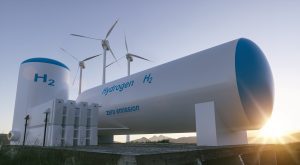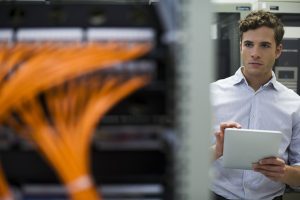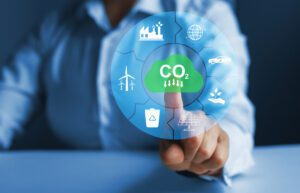Sustainability and business are two sides of the same coin for many companies today. With this changing outlook toward sustainability, business and technology leaders are facing the real challenge of securing the bottom line for their companies and improving productivity, while contributing to ambitious sustainability goals. The proliferation of digital technologies continues to accelerate, meaning industries require to support digitization by more IT resources. Initiatives aimed at measuring and optimizing the environmental footprint of enterprise IT systems are now more important than ever.
At Schneider Electric we developed a 4-pillar comprehensive Green IT program that measures, manages, and mitigates the environmental impact of IT. In my previous blog, I outlined the fundamentals of our IT-led strategy.
Today, I will be zooming in on a structural approach to IT devices. Why? Well, business IT devices currently make up to 54% of the IT sector’s CO2 emissions*. This means that companies can unlock this potential to significantly reduce GHG emissions. According to IT sector guidance, such as GeSi and Carbon Trust, 70% of the typical carbon footprint of business devices is included within the products, and 30% related to their usage. That is why tackling IT asset management is a good Green IT initiative for any business. However, it is one of the easiest and fastest approaches to reduce the carbon footprint.

Strategy 1: Choosing partners that commit to a low carbon economy
The carbon footprint of the electronics industry accounts for 4% of global greenhouse gas emissions, according to ID Tech Ex research. Reducing this impact is an enormous task for manufacturers who are reluctant to deviate from traditional methods and bet on innovation. Fortunately, many producers are taking greater responsibility for reducing their emissions. Today the manufacturer specifies the embodied and usage-related carbon footprint of smart devices. It becomes feasible to research and compare different electronics suppliers whose devices meet your company’s specific IT and business criteria. Your sustainable goals too!
But that was not the case when we were beginning our Green IT journey here at Schneider Electric. We knew that unlocking the potential to reduce GHG emissions of the enterprise IT fleet was a need. We focused our efforts on estimating solid sustainable targets and communicated to leading electronic suppliers what our expectations were. Finally, we found trusted vendors committed to collecting, tracking, analyzing, and reporting sustainability data. All of that with promoting transparency of their products’ embodied and usage-related carbon footprint.
From 2020, carbon footprint reduction is an integrated requirement in our IT vendor selection processes. Consequently, new PCs are up to 40% more energy efficient and have a 50% lower carbon footprint than the corresponding end-of-life equipment to be replaced.
This approach contributes to our sustainable ambition. From 2020-2022, we reduced the carbon footprint and energy consumption of our enterprise IT fleet by 5% each year.
Strategy 2: An end-to-end approach to circular computing
The concept of circular economy has been on the executive agenda for several years now. Since Schneider Electric is a manufacturing company, we are actively transforming our own products to extend their lifecycle. The concept of circular economy of reusing, refurbishing, and recycling can also be used throughout the entire lifecycle of IT assets.
The repairability level as well as the configuration level are key considerations here. High repairability of procured devices allows to increase the number of devices reused and refurbished, offering them a second life. Extending the PC replacement lifecycle may implicate a need to change baseline configurations (Central Processing Unit (CPU), Random Access Memory (RAM), or storage type to adapt them to the extended usage lifespan of the company.
At Schneider Electric, we implemented an IT Asset Disposal approach to consider sustainability and circular economy principles. We ensure that we give preference to Responsible Recycling (R2) standard or e-Steward compliant IT Asset Disposal vendors. In 2022, 6000 retired PCs got the second life. It was possible thanks to leasing services (mainly in Europe and North America), donations, and offering an Employee Purchase Scheme (mainly in Asia Pacific and China). Refurbishing IT devices can extend their lifespan by 7-8 years. Extended lifespan implies a decrease of the weighted yearly carbon footprint by up to 50%. It is done through the amortization of embedded Co2 emissions over time.
Strategy 3: What about carbon offsetting?
The term carbon offset refers to a reduction in GHG emissions. It also applies to an increase in carbon storage (e.g., through land restoration or the planting of trees). That is used to compensate for emissions that occur elsewhere. Even though some vendors focus on reducing the carbon emissions of their IT devices offers, others put their effort into carbon offsetting initiatives.
Carbon offsetting is an important part of climate strategy for many companies. Even though different offset projects have also different levels of effectiveness. As a global impact company, our priority is reducing our carbon footprint first. We aim to implement offsetting initiatives in this domain is an approach that we will be considering when indispensable only. For this reason, we are in continuous negotiation with our trusted vendors to commit to science-based, near-term targets that contribute to emissions reduction of their IT assets.
Also, we are working towards implementing other initiatives that can offer a sustained reduction in carbon footprint emissions from our various IT components in the coming years, which we hope to implement soon.
If this blog has been interesting for you and you want to learn more about our approach to reducing the carbon footprint of our business devices, along with reliable data and context, check out this whitepaper.
* Source: International Telecommunication Union (ITU) 2015



